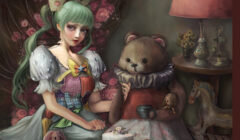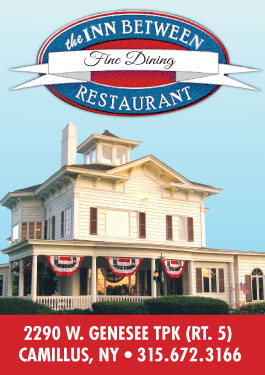The Storytelling Art of Francesca Horn
Little kids’ books are illustrated for a reason – the pictures help tell the story. But why stop enjoying the story of pictures when you’re no longer a child?
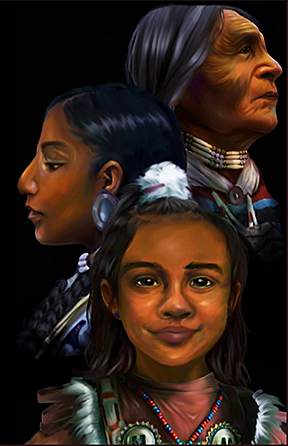
I found Francesca Horn’s art while visiting the Onondaga Historical Association. She had some postcards by the front desk, and they were so appealing I picked one up and remarked on it. As she was working at the desk, I got to meet the artist herself.
Storytelling using art isn’t anything new – pictographs are a simple form and represent a concept that leads to specific sentences; the art of a Maxfield Parrish or a Rembrandt uses form, color and light to convey the brilliance of an anatomy class or the activities of a militia company in a single painting.
Horn’s art tells, with light, color, shape and detail, a story you might not have heard before – but one that will start to form in your mind as soon as you see it.
I asked her a series of questions about the art, and here is that conversation:
1. When did you begin creating artwork?
“I’ve been drawing since I can remember. Whenever people ask, my mom always tells a story about me drawing a realistic volcano when I was around 3 years old in crayon and has encouraged me to pursue my artwork ever since. As a kid I would completely fill spiral notebooks full of my own comics and I would draw on almost anything. I started trying to take my work more seriously in terms of learning technique around middle school though.”
2. Do you have formal training?
“Nothing beyond the classes I took in high school. Although you can really learn so much from the free resources online and in books, you just have to know what to look for!”
3. What’s your favorite medium?
“Almost all of my pieces are mixed media, in part because I really heavily rely on layering and also in part because many of my pieces are digital which allows me to experiment with the techniques and effects of different mediums at the same time without the constraints of their physical properties mixing. But in my physical pieces, I’m always drawn back to chalk pastels and colored pencils.”
4. What inspires you?
“First and foremost I’m generally drawn to things that are cute but unsettling. It may sound macabre but I’m most inspired by things that are abandoned or lost to time. I like old things like antique dolls that have clearly been loved but don’t have a defined past. Things that have an untold story give me an opportunity to imagine what past life they might have come from, and that’s how I like to start almost all my concepts.”
5. Do you have any favorite artists?
“One of my favorite artists or rather artist (animation) troupes is Gekidan Inu Curry. Their style is delightfully maximalist in a way that I hope to parallel in some of my own work, utilizing environmental storytelling and symbolism throughout each piece. My style has also been influenced by Margaret Keane’s work not only in aesthetics, but also through the manner in which her portraits use eye contact with the viewer as a narrative tool. Although not a physical painter like myself, I would feel remiss if not to mention Mary Rushton, the artist behind the now antique line of Rushton dolls from the 50s and 60s. Her creations’ style and aesthetic has continued to inspire me in all my artistic pursuits. (Note: Margaret Keane is the artist whose work was nominally the work of Walter Keane, her husband – who was quite famous in the 60s for a series of works featuring characters with huge, urgent eyes. The two battled in the 80s for actual credit for the work, with final authorship going to Margaret!)
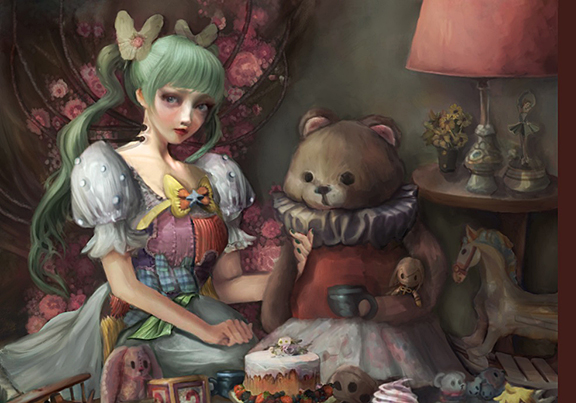
6. I see stories in your work – is that what you intend?
“It is absolutely my intention to tell stories through my paintings. I want people who view my work to feel like they are a part of the scene I’m portraying or in the room with the person in my portrait.”
8. Where do you show your work?
“Physically, anywhere that will host me, although I don’t currently have any public exhibits. Digitally my work is on Facebook under Francesca Horn on my business page.
9. How can people see it?
“I have a digital gallery and some contact information on my website: mothchan.wixsite.com/francesca. I periodically update with my latest works every month or so, so keep an eye on the space if you’re interested!”
10. Do you do portraits, book illustration, etc.
“I do all of the above! I’ve done a lot of work in realistic or semi/realistic portraiture, I’ve done pixel art, comics, cartoons, almost any style of artwork for commissions. I’ve been recently working on paleoart inspired by an exhibit at the Museum of the Earth in Ithaca.”
Finally, I challenged Francesca to tell the story of three of her pieces. But I suggested that we each tell the story – as seen, and as intended, and see how the two stories matched up – or didn’t!
And, in a very abbreviated form, here’s how that went:
Mad Tea Party
My story: There was a young girl who had many toys and stuffed animals…she enjoyed creating stories, writing poems, and in particular, she liked spooky things – like Halloween, ghost stories, dark corners of the house, and mysteries. One day, she decided to give herself and her old childhood toys a treat – a tea party! And once everything was in place, she told the toys to help themselves. As she was getting ready to take a cupcake, she heard a soft voice say, “Thank you for remembering us.”
Francesca said: “This painting was actually made for a music festival under the prompt “Toybox,” which has long served as an alternate title for the piece. In my narrative, after years of illness and loneliness, the young girl depicted has put on her finest handmade patchwork clothing to have a long needed celebration with all the childish things of her youth, her dolls, her toys, her favorite sweets.
Your interpretation of this painting was almost spot on. My favorite part of your retelling was the most important part of the piece, and that is seeing the life and borderline sentience of the toys and items themselves.”
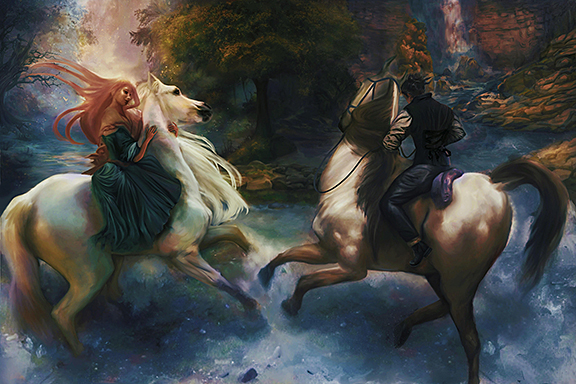
No More Stolen Sisters
My story: A mother and a daughter are separated when their tribes fight, each ending up with the other tribe, one as an adopted mother, the other as an adopted daughter. When the two tribes are getting ready to fight again, many years later, the mother, daughter, and now a granddaughter see one another, recognize their relationship, and urge all the people to live together in peace. And they do.
Francesca said: “This piece was made while I was still in high school and was reconnecting with my roots and family history. I made this piece in support of the effort to give tribute and raise awareness about the disproportionate disappearance rates and violence faced by Indigenous women.”
I think your story was an excellent snapshot of the familial bond and love the Indigenous women in this painting represent and a very accurate characterization of the story I was trying to tell.“
Forest Nymphs
My story: Ian was a young adventurer. He enjoyed exploring, and taking long, lonesome rides on his beautiful buckskin stallion, Fury. He meets an old man who lives in the deep woods, helps him with food and listens to his stories, particularly the one about the Forest Nymph, whom Ian would dearly love to meet. One day he becomes lost in the mists, and encounters a mysterious girl, also riding a horse. The two are frightened of one another, but their horses know something they don’t. The horses charge at one another, as if to fight, but instead, greet one another peacefully, and they have introduced Ian and the nymph.
Francesca said: “This was one of the largest pieces I’ve ever worked on; it was made for a charity auction at the Crackerbox Palace farm sanctuary. While making the piece, I imagined a beautiful woman who was known for riding in the woods, the “nymph” of local legend. The dark haired rider alongside her on the other hand I imagined to be a distant and solitary traveler who came upon the young woman, only interested in the transactional elements of their alliance.
Your interpretation of this story is much more optimistic than mine and I like the shift. This type of interpretation is what makes me want to keep telling stories because I find myself more attached to your characterization of the dark haired rider than my own. It certainly makes me want to like him more!”
And she concludes: “My favorite part about hearing viewer interpretations of my art is that my intended story is no longer the sole experience of viewing the piece. It is one of many narratives, all of which are equally true. Once I show a piece to the world, I no longer feel ownership of its narrative, I feel as though that piece belongs to the viewer and it means whatever they feel when they look at it.”

